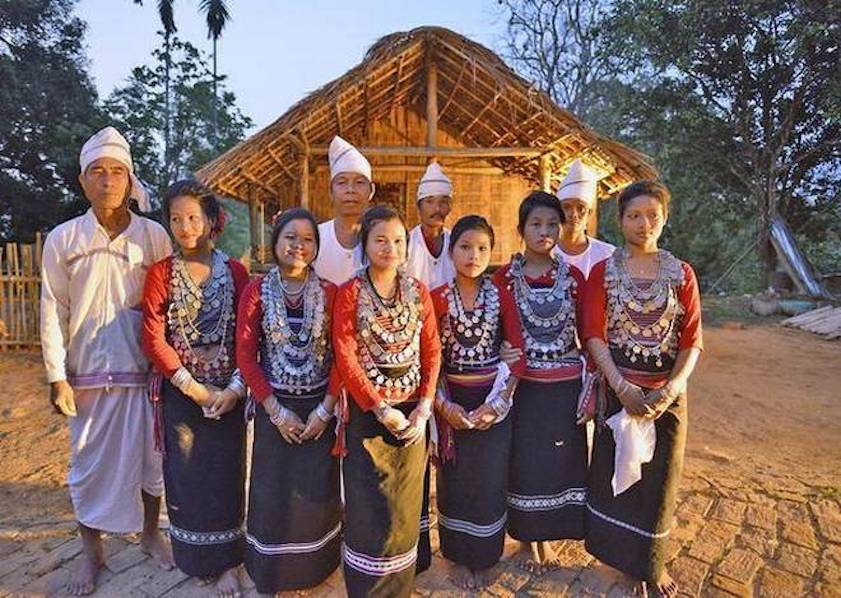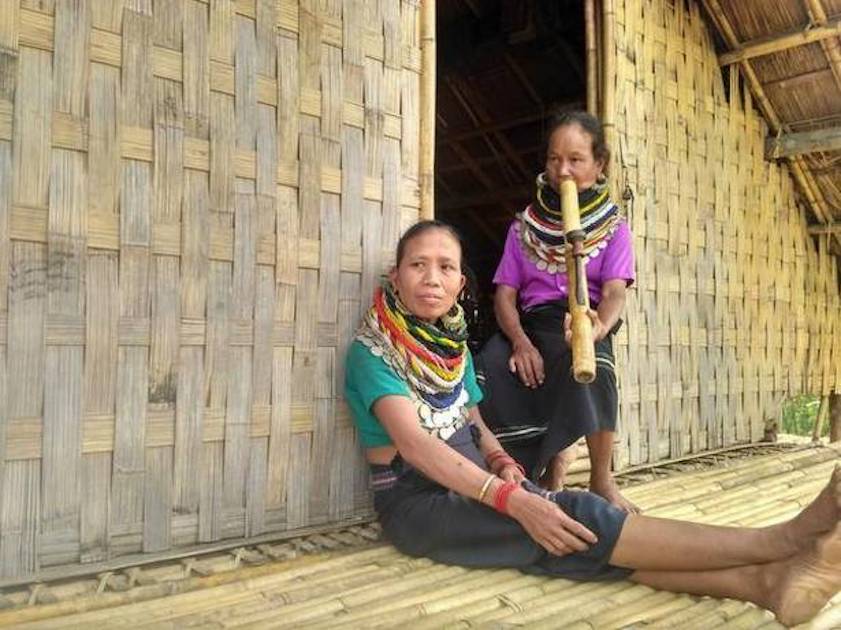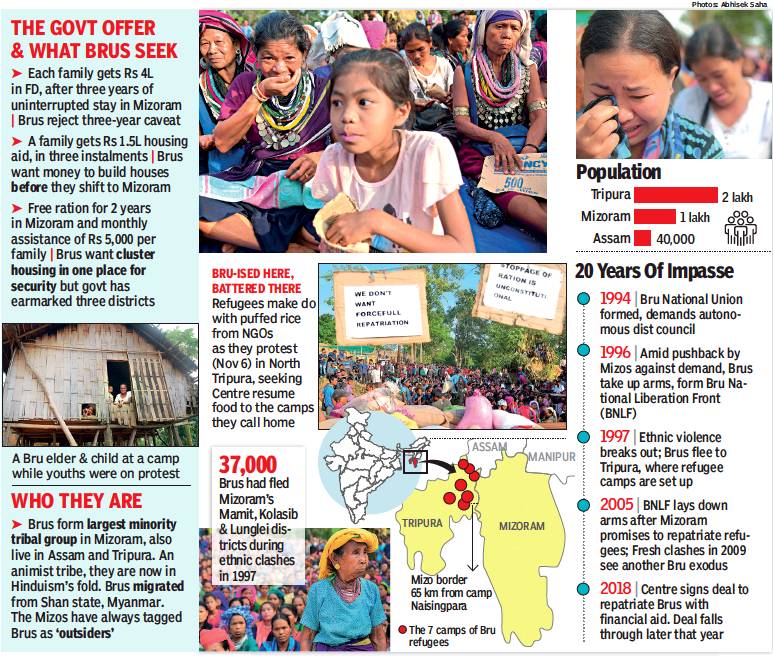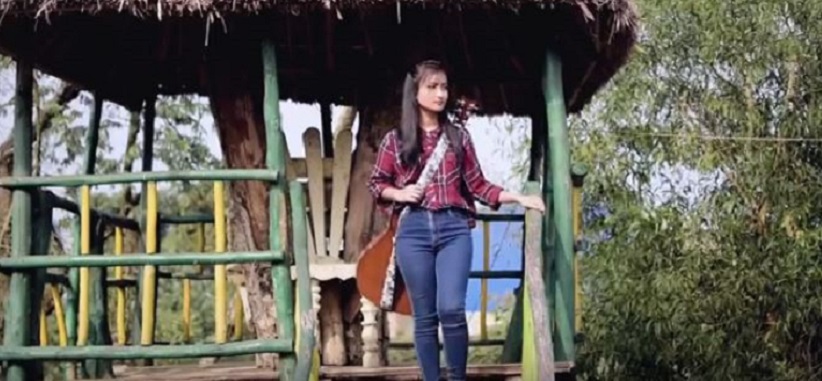Reang/ Bru
This is a collection of articles archived for the excellence of their content. |
Contents[hide] |
Introduction
Shiv Sahay Singh, May 27, 2017: The Hindu

From: Shiv Sahay Singh, May 27, 2017: The Hindu

From: Shiv Sahay Singh, May 27, 2017: The Hindu
More than 100 km from the Tripura’s capital of Agartala, at the Karnamanipara village in Dhalai district, Chandirung and Phitarung are the only women who can be spotted wearing traditional Reang jewellery called lukoih (a unique necklace made of colourful beads) and rangbauh (a necklace made of coins).
The author, a Professor of history at Tripura University, who himself belongs to the Reang community, has collected field data from 189 Reang-inhabited village councils/gram panchayats covering 28 blocks from six out of the eight districts of Tripura (2017).
“Members of the Reang tribe are generally known to be shy and hardly ever depart from their traditional way of life. Till a few decades ago, they did not mix with people of other communities. However, over the past few years, changes have slowly started creeping into their way of life. Documenting and preserving the centuries-old heritage becomes all the more important,” Professor Reang said.
Culture
Traditions
Manindra Reang, State Minister for Tribal Welfare, said that a museum dedicated to the culture of the Reang tribe is being set up at the office of the department in the Gorkha Basti area of Agartala. The museum seeks to showcase cultural aspects of Reang life in attire, ornaments, dance and rituals.
Reang millennials
See graphic
Hamjakma Reang is a pop singer and guitarist who, inert alia, sings Hindi-Urdu and Punjabi songs.
Dance
One of the unique dances of the Reang is the Hodaigiri/Hojagiri, in which a group of women balance themselves on earthen pitchers and manage other props. The performance is associated with the harvest.
Education
Data from the field
One of the concerns highlighted in the publication by Professor Reang is the limited access to education.
“Our survey revealed that the educational profile of children between the age group of 6-14 years was not satisfactory. Out of 45,532 children in this age group, 40.9% boys and 38.6% girls are not in school,” he said.
Education has been pressing a concern for the tribe. As per the 2001 census, 66.93% of the Reang population is illiterate.
Language
The Reang dialect is of Tibetan-Burmese origin and is locally referred to as Kau Bru. Though there is no script for the language, some publications follow the Bengali or Roman script to keep the language alive.
Occupation
Jhum cultivation
Traditionally, jhum (shifting) cultivation has been one of the primary agricultural activities of the Reang tribe. However, with land rights being granted, many members of the community have taken to ploughing or settled cultivation.
“In terms of agriculture, the survey revealed that only 13.8% members of the community are practising shifting cultivation while 35.2% are engaged in settled agriculture. About 13.1% of the tribe depend on the collection of minor forest produce for their livelihood while 19.8% are agricultural labours,” Professor Reang said.
Bru refugees in Tripura
2018: Planned return to Mizoram
The Centre is working overtime to ensure a smooth homecoming for Mizoram’s 32,875 displaced Bru people after their 21-yearlong exile in Tripura, all in time for the assembly election later this year.
Besides setting strict deadlines for the resettlement process — including setting up bank accounts and allocating additional land for construction of toilets — the Centre has set a September deadline to update the names of the refugees on the voter list.
Mizoram, the last remaining Congress bastion in the north-east, is slated to go to the polls in December. In 2014, the Election Commission had carried out a special revision of voters in the six
refugee camps of north Tripura where the Bru families were living. A total of 11,243 voters were eventually included in Mizoram’s electoral rolls and allowed to vote in the Lok Sabha election through postal ballots. The move had met stiff opposition from several Mizoram organisations, who said the Brus should not be allowed to vote if they did not stay in Mizoram.
BJP dismissed the possibility of political dividends as a result of the move. “It’s good that they are returning to Mizoram... But I wouldn’t say that BJP will reap the benefits in terms of votes in December. Congress has a strong base among Bru voters, as does the Mizo National Front,” president of BJP’s Mizoram unit JV Hluna said. “We are concerned that though the Centre was instrumental in the repatriation of the Bru families, the implementation of the repatriation schemes will be under the aegis of the state government, which is ruled by Congress.”
The Brus, also called Reangs, have been living in six relief camps in north Tripura areas adjoining Mizoram since 1997 after they fled their homes following ethnic violence.
2019: Reluctance to return to Mizoram
Amava Bhattacharya, Nov 9, 2019: The Times of India

From: Amava Bhattacharya, Nov 9, 2019: The Times of India
For hours, Zoremi Moshoy refused to leave the bedside where her year-old infant, Akosa, lay. That she had helplessly watched her child die was impossible to process. And that it had been over just Rs 5 and 600g rice a day more so.
For every Bru refugee in Tripura, displaced from Mizoram over the past two decades by ethnic clashes, the government aid of Rs 5 and 600g rice a day has been the sole means of sustenance. On October 1, the Centre decided the aid had to stop — the Brus had lived in Tripura camps long enough and it thought it was time they went “home” to Mizoram. By cutting off all supplies, perhaps the process could be sped up.
Last October, too, the Centre had stopped aid for a few days, hoping it would push the refugees across the border to their designated homes. But the Mizoram election was drawing closer and it softened administrative resolve. The move was withdrawn.
This time also government has relented, resuming supplies after a week-long protest. But in the unequal game of who blinks first, six Bru refugees died. Four of them were children — three-month-old Ojitrai, four-month-old Pigili Reang, Akosa and two-year-old John Chongprengh. Two others, Bistirung Reang and Makota Reang, were older than 60.
Within the refugee camp, the reason is clear. “Hunger weakened them. Most people here don’t have enough to eat,” said Bruno Msha, general secretary of the Mizoram Bru Displaced Peoples’ Forum.
Government has refuted the premise and acknowledged only four deaths. “Two children and two adults have died in Naisingpara. Their bodies were buried. We exhumed the body of an adult for postmortem but the report will take a month. Till that happens, we can only say they died of unknown causes,” subdivisional magistrate of Kanchanpur, Abhedananda Baidya, said.
For the past week, the Dasda-Anandabazar road, off NH-8 in North Tripura district, had been occupied by over 300 refugees from all seven camps, demanding state aid be resumed. As the crisis deepened, Tripura deputy CM Jishnu Dev Varma announced government would resume supplies. But only till November 30, by when government plans on completing the Bru repatriation. “You can’t live as refugees forever. You must accept the rehabilitation package and move back to live with dignity,” Dev Varma told the Brus.
But the Brus don’t want to go to Mizoram, and not on the terms the government has laid out. For many, memories of Mizoram don’t exist, have faded or are ones they’d rather not hold on to. The camps in Tripura have very little to offer — no healthcare, no schools, no jobs. The drinking water is muddy, the thatched huts are crumbling. But there is peace and no fear of persecution.
In Mizoram’s impenetrable Christian society, communities like Bru and Chakma have always been seen as “outsiders”. In 1997, the tension between Mizo and Bru communities came to a head when a Bru militant allegedly gunned down a Mizo forest guard. In the retaliatory violence, around 50,000 Brus fled to Tripura. Today, refugee camps have about 30,000 members.
Sentiments about Brus across the border in Mizoram remain the same. Before the last repatriation attempt, the Young Mizo Association (YMA), Mizoram’s most powerful social organisation, had said “too many people will migrate to Mizoram if they think of it as their land”. Now, the stand is cautious but just as exclusionary. “If Brus want to stay on in Tripura, there must be a hidden agenda. Ask them why they don’t want to come back,” said Vanlalruata, president of YMA.
The realisation is not lost on the protesters. “Can the Centre guarantee our safety in Mizoram? The Christian Mizos won’t allow us our own identity,” said 25-year-old David Molshoi, a protester.
“We’re happy ration will be resumed. But as we said, this was our immediate demand. Our larger demands remain unmet and should be fulfilled before we are sent back… How will we survive? Most youths in the camps are idle as they are unlettered. Where will they find work to earn and buy food?” asked Msha.
Their long-term demands have made the repatriation process, which began in 2010, drag on. “Even if the Centre resumes ration for a few days, we will not go back unless rehabilitated in cluster villages in Mamit, Kolasib and Lunglei districts for our security. We’re to get Rs 1.5 lakh to build houses after we return to Mizoram, but we want the money now. We want to build the houses first and then consider taking our families,” said Msha.
The Mizoram border is just 65 km from the largest refugee camp in Naisingpara, but for the Brus — India’s own Rohingya — the journey from camp to “home” has been, and will continue to be, a long one.
2020: Pact signed, Bru refugees to settle in Tripura
Bharti Jain, January 17, 2020: The Times of India
NEW DELHI: Seeking to put an end to the 23-year-old Bru-Reang refugee crisis, a quadripartite agreement was signed among the Centre, state governments of Tripura and Mizoram and Bru-Reang representatives on Thursday to facilitate permanent settlement of Bru refugees in Tripura with a Rs 600-crore rehabilitation package. The agreement will benefit around 34,000 Bru persons currently living in six camps in Tripura. They were forced to flee from Mizoram following ethnic tension in 1997.
Home minister Amit Shah presided over signing of the “historic” pact. Others present included Tripura chief minister Biplab Kumar Deb, Mizoram chief minister Zoramthanga, North-East Democratic Alliance chairman Himanta Biswa Sarma, Tripura royal scion Pradyot Kishore Debbarma and Bru representatives.
Shah said that a permanent solution to the issue could be arrived at under the “dynamic leadership of Shri Narendra Modi”. “Bru-Reang people in Tripura can now look towards a bright future,” he said adding that around 34,000 Bru refugees would get residential plots to settle in Tripura, apart from all rights of normal residents and also be eligible for benefits of social welfare and entitlement schemes of the Centre and state government.
While a tripartite pact was signed by the Centre, Mizoram government and Bru representatives in 2018 envisaging repatriation of displaced Bru refugees to Mizoram, barely 328 families returned to Mizoram. The rest, having been living in Tripura for close to three decades, were reluctant to move out.
The Centre thus started fresh negotiations to find a solution to the Bru people’s demand that they be allowed to settle down in Tripura.
The home minister told newspersons that as per the new agreement, each of the Bru families living in Tripura will be given a 40x30 sq ft. residential plot, in addition to a fixed deposit of Rs 4 lakh, Rs 5,000 cash aid per month for 2 years, free ration for 2 years and Rs 1.5 lakhs aid to build their house. The government of Tripura would provide the land under this agreement.
Himanta Biswa Sarma commended Tripura chief minister for pledging the land. “The refugees who were living in very poor conditions will now get to live in their own home,” Sarma said after the signing ceremony.
Shah mentioned about how the northeast region is being put on the path of fast-paced development under Modi. He talked about the recent surrender of 88 armed insurgents of the NLFT(SD) group and assimilating them into the mainstream.
This major step, along with the Bru-Reang agreement today, is an important milestone in bringing fast-paced development to the state of Tripura, he said.
